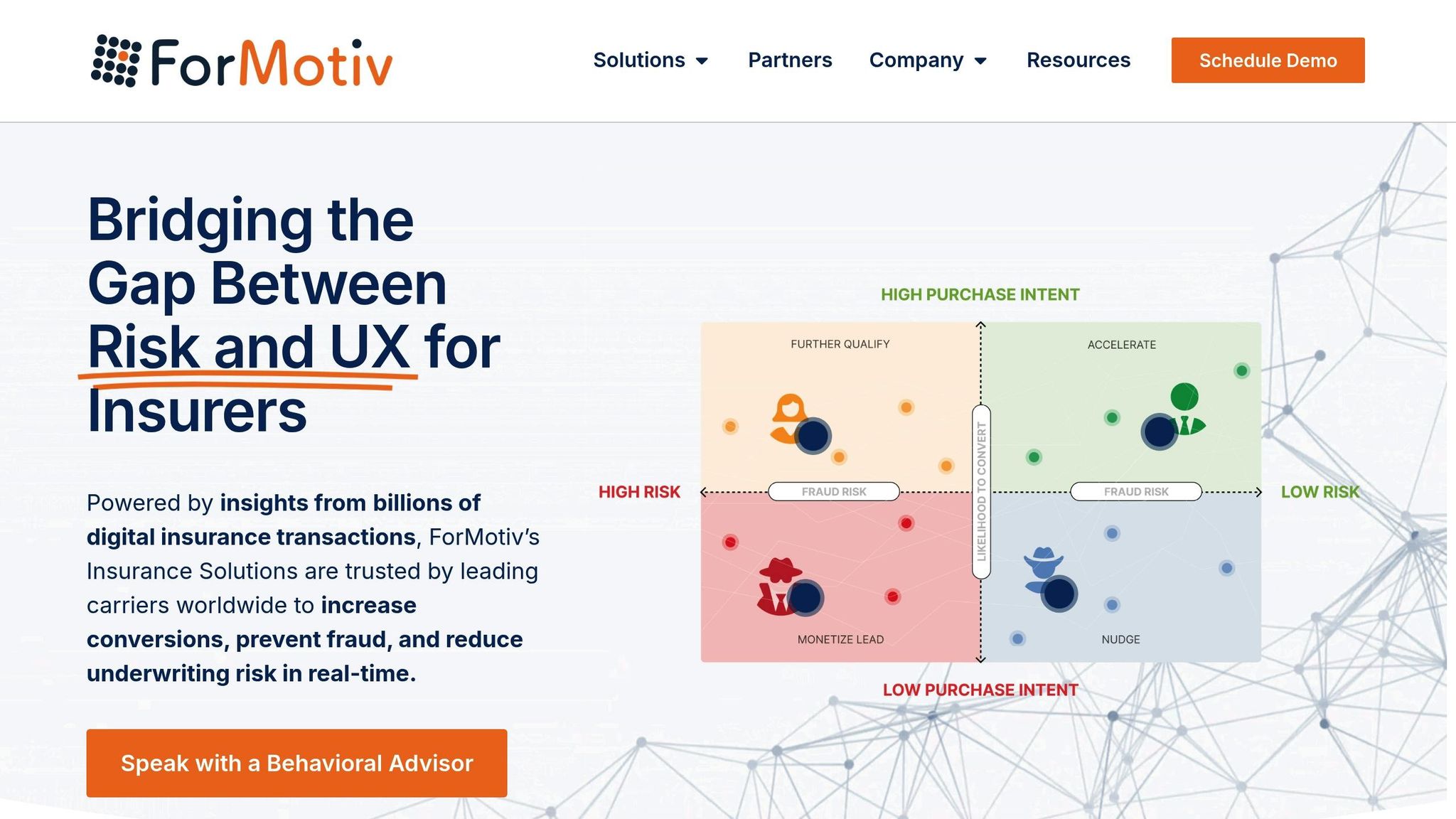Behavioral analytics is transforming how insurance companies detect fraud in the digital age. By analyzing subtle online behaviors like typing speed, hesitation, and corrections during an application process, insurers can identify fraud in real time – before a policy is issued. Traditional methods relying on static rules and post-application reviews struggle to keep up with sophisticated schemes, costing the industry $308 billion annually.
Key takeaways:
- Behavioral signals such as rapid form completion, excessive corrections, and inconsistent typing patterns often indicate fraudulent intent.
- Platforms like ForMotiv analyze these behaviors, offering real-time insights to reduce fraud losses and improve underwriting decisions.
- Machine learning plays a critical role, detecting anomalies and continuously improving detection accuracy.
- Fraud costs U.S. insurers billions annually, with 10% of property and casualty claims being fraudulent.
ForMotiv’s platform integrates easily into existing workflows, ensuring compliance with data privacy laws while helping insurers save on fraud-related losses. By leveraging behavioral data, insurance companies can better protect their portfolios and reduce premium costs for honest customers.
To Catch a Thief: Explainable AI in Insurance Fraud Detection | Ville Satopaa & Antoine Desir
Behavioral Signs of Insurance Fraud
The rise in fraudulent online applications has become a pressing issue, with application integrity dropping by more than 20% [2]. Detecting these schemes often comes down to identifying subtle, yet telling, digital behaviors. Below, we explore key patterns that can help distinguish between honest and fraudulent insurance applications.
Digital Behaviors That Signal Fraud
Fraudsters often leave behind digital clues that reveal their intentions. Behavioral analytics can pick up on these patterns, which are often tied to the pressure of maintaining a fabricated story.
One major red flag is rapid form completion. When someone breezes through a detailed insurance application unnaturally fast – especially forms requiring thoughtful answers – it often points to pre-prepared, false information. Legitimate applicants, on the other hand, take their time, especially when answering sensitive questions about medical history, driving records, or property details.
Another telltale sign is excessive corrections. Fraudsters, trying to keep their fabricated story straight, may frequently delete and re-enter information, revisiting fields far more often than genuine users.
Typing patterns also offer clues. Inconsistent typing speeds – slowing down or speeding up dramatically – can indicate a shift between truthful and fabricated responses. Similarly, abnormal hesitation on certain questions, such as those about smoking habits or health conditions, may suggest someone is crafting a false narrative.
These behaviors serve as a foundation for comparing normal user activity to suspicious deviations, helping insurers spot potential fraud early.
Normal Behavior vs. Suspicious Patterns
Honest applicants tend to follow a predictable rhythm when filling out forms. They maintain steady typing speeds, navigate logically from one section to the next, and take a reasonable amount of time based on the complexity of the questions.
Legitimate users also display natural correction patterns – minor edits here and there that align with typical human error. In contrast, fraudsters often exhibit erratic behaviors, such as sudden pauses, excessive backtracking, or unusual navigation paths.
Companies leveraging predictive analytics have seen significant improvements in fraud detection. For instance, identifying these behavioral anomalies has reduced inflated claims processing times by 50% [6].
"Behavioral biometrics invisibly helps verify users by analyzing the way they physically interact with a website or mobile application." – LexisNexis [4]
Machine learning tools can pinpoint suspicious behaviors almost instantly, with detection rates surpassing 90%. This is a game-changer compared to manual reviews, which can miss up to 30% of fraud cases [6]. A key indicator is inconsistent behavior across sections of an application. While genuine applicants maintain steady patterns, fraudsters often display noticeable changes when switching between truthful and fabricated responses.
Common Fraudulent Behaviors in Online Applications
Certain patterns are especially common among fraudulent applications, providing insurers with additional clues to spot dishonesty.
Data reuse is a frequent tactic. Fraudsters often recycle the same personal information across multiple applications, leading to behaviors like copy-pasting or unusually fast data entry in fields that typically require careful thought.
Erratic navigation is another red flag. Genuine users tend to move through applications in a logical, step-by-step manner. Fraudsters, however, might jump between sections, revisit completed areas multiple times, or spend disproportionate time on specific pages.
Suspicious timing also stands out. For example, completing a complex life insurance application in under five minutes or submitting multiple applications from the same device in a short period often points to fraudulent activity.
The financial impact of these behaviors is staggering. Auto insurance carriers lose around $30 billion annually due to fraud-related premium leakage. In life insurance, about 7% of policies involve some form of misrepresentation, contributing to roughly 17% of total claims [2]. Non-disclosure of smoking alone costs insurers $4 billion each year [2].
Another common scheme involves ghost brokers, who display consistent behavioral patterns due to their systematic methods. These operations often feature identical completion times, similar navigation behaviors across applications, and timing patterns that suggest automation or semi-automation.
Platforms like ForMotiv analyze billions of digital insurance transactions, enabling insurers to detect both organized fraud rings and individual bad actors before policies are issued. This proactive approach is essential in combating the estimated $40 billion in annual fraud losses reported by the FBI [3].
Methods for Analyzing Behavioral Patterns
Shifting from rigid, rule-based systems to dynamic, behavior-driven analysis has changed the game in fraud detection. Insurance companies are now adopting advanced technologies that evolve with new fraud trends, leaving outdated static systems behind.
Machine Learning for Fraud Detection
Machine learning has revolutionized how insurers identify fraudulent activities. By analyzing massive datasets, these algorithms can pinpoint unusual patterns and define what "normal" behavior looks like. Unlike traditional methods that depend on fixed rules, machine learning systems adapt continuously to new fraud tactics.
For example, machine learning can detect inconsistencies in customer data, like mismatched addresses, questionable transaction histories, sudden account changes, or odd behaviors during the application process. Behavioral biometrics, such as typing speed, mouse movements, and navigation patterns, add another layer of analysis to spot unauthorized access or suspicious intent.
The results speak for themselves: machine learning can identify fraudulent healthcare claims with an impressive 92% accuracy [9]. This precision comes from analyzing multiple data streams – historical claims, real-time behaviors, and external verification sources. Feedzai reports that 90% of global banks already use AI and machine learning to combat fraud [9]. The market for AI in fraud detection is expected to grow to $108.3 billion by 2033, with an annual growth rate of 24.5% [9].
ForMotiv provides a great example of this approach. As they describe:
"ForMotiv analyzes applicants and agents’ digital body language, such as typing speed, time spent, keystrokes, corrections, and hundreds of other digital behaviors, as they go through the online quoting and binding process" [7].
This type of analysis gives insurers critical insights into an applicant’s intent during the application process, laying the groundwork for more sophisticated fraud detection systems.
Building Better Fraud Detection Models
Creating effective fraud detection models starts with selecting the right behavioral features. The best models combine data from various sources and analytical techniques to get a full picture of applicant behavior.
Unsupervised models are particularly effective at uncovering fraud patterns that haven’t been explicitly identified. As Joao Veiga, Senior Manager of AI at Feedzai, explains:
"Unsupervised models go after the known unknowns. There’s a lot of activity that we know looks suspicious, but we don’t even know what to look for" [9].
These models excel at spotting anomalies without needing prior training on specific fraud scenarios.
Feature engineering plays a critical role here. It involves identifying behavioral indicators that provide valuable insights while minimizing false positives. Key features often include:
- Temporal patterns: Tracking how users interact with forms over time, such as pauses, completion speeds, and revisits.
- Navigation behaviors: Observing how users move through applications, including backtracking or skipping sections.
- Input characteristics: Analyzing typing rhythms, correction rates, and overall consistency in data entry.
Combining behavioral data with traditional verification methods further enhances model accuracy. Insurers can use data enrichment techniques to gather additional information about a person’s history, financial background, and behavioral trends from external sources [11]. This multi-layered strategy reduces false alarms while maintaining high detection rates.
ForMotiv’s platform illustrates this approach:
"We combine this proprietary, first-party behavioral dataset with real-time predictive analytics to identify which of your applicants are genuine, risky, or fraudulent during the underwriting flow" [7].
By integrating behavioral analytics with predictive modeling, insurers can develop fraud detection systems that are both reliable and precise. These insights feed directly into real-time detection systems, which are discussed next.
Real-Time Analysis in Insurance Workflows
Real-time analytics bring fraud detection directly into the application process, allowing insurers to identify risks instantly. This proactive approach ensures that fraudulent activities are flagged before policies are issued, rather than being discovered later during claims processing.
AI systems can cross-check new applications against historical data in seconds, flagging anomalies that need further review [10]. This rapid analysis ensures data integrity while the applicant is still engaged.
The technology stack for real-time analysis typically includes natural language processing to analyze text data, machine learning for pattern recognition, and cloud computing for scalable processing power [8]. Together, these tools provide fast and thorough fraud detection that keeps up with the speed of digital transactions.
Continuous monitoring is another essential component. Machine learning systems improve over time by analyzing new data, reducing the chances of fraudulent activities slipping through [10]. Feedback loops further enhance these systems, ensuring they adapt to ever-changing fraud tactics [11].
The financial impact of real-time analysis is immense. By adopting AI-driven technologies across the claims process and integrating real-time analytics, property and casualty insurers could save between $80 billion and $160 billion by 2032 [1]. Currently, about 10% of P&C insurance claims are fraudulent, costing the industry $122 billion annually [1].
Real-time fraud detection outperforms traditional methods by offering immediate, actionable insights. While older approaches often rely on slow, batch-based processing, machine learning provides instant alerts [9]. ForMotiv’s real-time capabilities allow insurers to capture behavioral data as it happens, offering instant insights into applicant intent. This enables insurers to prevent fraudulent policies and make better underwriting decisions, ultimately strengthening their portfolios.
sbb-itb-ec84a5c
ForMotiv‘s Behavioral Fraud Detection Solutions

ForMotiv’s behavioral analytics platform is reshaping how U.S. insurance companies detect fraud and assess risk. By analyzing behavioral data in real time, the platform helps insurers make smarter decisions during the underwriting process and blocks fraudulent applications before they become an issue.
ForMotiv’s Behavioral Analytics Platform
ForMotiv processes over 5,000 real-time data points for every application it analyzes[13]. By monitoring digital behaviors like typing speed, hesitation, corrections, and navigation patterns, the platform provides actionable insights in under 20 milliseconds. This ensures there’s no delay in the application process[16].
The platform leverages advanced machine learning to uncover subtle behavioral cues that reveal an applicant’s intent and motivations[12]. Unlike traditional fraud detection methods, ForMotiv identifies nuanced indicators of deception or risk, offering an entirely new layer of understanding.
What sets ForMotiv apart is its ability to contextualize behavior. For instance, the company asks:
"Is your applicant high-intent because they bought a car this morning or because they got in an accident this morning?"[7]
This kind of insight helps insurers grasp not only what applicants are doing but also why they’re acting a certain way. By creating a comprehensive view of each applicant’s intent, insurers can tailor their responses to individual cases. ForMotiv’s "glass-box approach" ensures that all behavioral signals, models, and features are accessible in real time via API or batch files[7].
Benefits for U.S. Insurance Companies
ForMotiv’s advanced analytics provide measurable benefits for insurers. Fraudulent claims and misrepresentation add an estimated $400–$700 annually to the average family’s insurance premiums[12].
The platform supports multiple insurance sectors, including life, auto, commercial, property, pet, and jewelry insurance[7]. It tackles various fraud scenarios, such as material misrepresentation and non-disclosure. For example, in life insurance, about 7% of policies involve some level of non- or under-disclosure, which grows to nearly 17% when policies mature into claims – adding up to more than $12 billion in costs[14].
ForMotiv also analyzes agent behavior, which has proven to be a game-changer. In one case study, a Top 10 Life Insurance carrier discovered that 72% of applications had at least two questions corrected by agents after submission[14]. This insight prompted the carrier to remark:
"You helped us find the agents who represent themselves better than their employer and customer."[14]
The platform enables insurers to prioritize applications showing signs of risk, ensuring appropriate next steps are taken[12]. It addresses multiple risk areas, including:
- Premium Leakage: Spotting incomplete or inaccurate information that leads to underpricing.
- Non-Disclosure: Detecting when applicants omit critical details, such as tobacco use – a $4 billion issue on its own[12].
- Material Misrepresentation: Identifying deliberate falsification of information.
- Underwriting Risk: Evaluating applicant risk through behavioral patterns.
Data Privacy Compliance and Easy Integration
ForMotiv prioritizes data privacy by ensuring no Personally Identifiable Information (PII) is captured[7][16]. The platform complies fully with GDPR, CCPA, and PIPEDA regulations, making it suitable for insurers operating across various jurisdictions[7][16].
Integration is designed to be straightforward. ForMotiv uses lightweight JavaScript that doesn’t affect system performance[7][16], allowing insurers to implement the platform without major system overhauls. Data is processed and stored securely using AWS technology, with encryption applied both in transit and at rest[15]. Strict confidentiality measures are also enforced for employees and contractors[15].
The platform’s flexibility extends to modern development tools. In December 2020, ForMotiv partnered with Unqork, a no-code platform, to integrate behavioral intelligence without requiring coding expertise. This collaboration allows insurers to build applications that adapt dynamically to user behavior. For example, if a customer shows signs of abandoning the process, the application might highlight a click-to-call option to re-engage them.
As Nilay Doshi, head of P&C insurance at Unqork, noted:
"It is now extremely easy to grab a lot of behavioral data, a lot of insights and analytics from how people are interacting with Unqork-built solutions, and that’s where we see our partnership with ForMotiv can become extremely valuable for our clients."[13]
Key Takeaways
Fraud schemes have grown increasingly sophisticated, leaving traditional methods struggling to keep up. In 2022 alone, Americans lost nearly $8.8 billion to fraud, marking a sharp 30% jump from the previous year. This surge highlights the pressing need for advanced defenses, and behavioral pattern analysis has emerged as a powerful tool against these evolving threats [5]. These trends set the stage for technological breakthroughs that are reshaping fraud detection.
The Future of Behavioral Fraud Detection
As payment systems speed up and criminals refine their tactics, the fraud detection landscape is undergoing a major transformation. The market for fraud-detection technology is expected to skyrocket from $4 billion in 2023 to $32 billion by 2032 [1]. Unlike older systems that rely on rigid rules and manual oversight, behavioral analytics leverages continuous learning from data. This approach not only reduces false positives by 20–50% but also improves detection rates by 15–20% [18].
Real-time analysis has become a game-changer, especially as fraudsters take advantage of faster payment systems. TJ Horan, Vice President of Product Management at FICO, elaborates:
"Behavioral analytics use machine learning to understand and anticipate behaviors at a granular level across each aspect of a transaction." [17]
This deep understanding enables insurers to shift from merely reacting to fraud to proactively preventing it. By identifying suspicious patterns early, insurers can stop fraudulent claims before they escalate into costly payouts. Platforms like ForMotiv exemplify this shift by offering real-time, adaptive intelligence to combat fraud effectively.
How ForMotiv Helps Prevent Insurance Fraud
ForMotiv’s platform delivers real-time fraud detection, directly addressing the core challenges faced by U.S. insurers. According to Deloitte, P&C insurers could save between $80 billion and $160 billion by 2032 through the adoption of AI-driven technologies across the claims process [1]. ForMotiv empowers insurers with behavioral intelligence, enabling smarter underwriting decisions and reducing exposure to fraudulent claims.
The platform’s capabilities extend beyond fraud detection to include bot identification, prevention of identity harvesting, mitigation of premium leakage, and detection of misrepresentation. This comprehensive approach provides insurers with a complete view of risk that traditional methods simply cannot achieve.
Next Steps
To stay ahead of fraud, insurers must embrace behavioral analytics as a cornerstone of their risk management strategies. Shifting from outdated, rules-based systems to advanced behavioral intelligence requires planning, but the rewards are substantial: lower fraud losses, enhanced customer experiences, and greater operational efficiency.
ForMotiv offers a straightforward entry point with its easy-to-implement JavaScript integration. The platform complies with GDPR, CCPA, and PIPEDA regulations, ensuring seamless adoption. It supports a wide range of insurance lines, including life, auto, commercial, property, pet, and jewelry, making it an ideal solution for carriers of all sizes. With 10% of P&C claims being fraudulent, costing $122 billion annually [1], insurers that adopt these technologies now will be better equipped to protect their customers, reduce financial losses, and maintain a competitive edge in an increasingly demanding market.
FAQs
How does behavioral analytics enhance fraud detection in the insurance industry?
How Behavioral Analytics Improves Fraud Detection
Behavioral analytics takes fraud detection to the next level by examining real-time user behavior during the insurance application process. Unlike older methods that depend on static data or manual evaluations, this approach identifies subtle behavior patterns and anomalies that could signal fraudulent activity. The result? Faster, more precise fraud detection.
Using advanced tools like machine learning and automation, behavioral analytics helps insurers anticipate user intent, cut down on false positives, and flag high-risk applications early in the process. Solutions from platforms like ForMotiv cater to different types of insurance, helping carriers reduce fraud, lower underwriting risks, and streamline fraud prevention efforts.
What types of digital behaviors does ForMotiv analyze to detect insurance fraud?
ForMotiv takes a deep dive into digital behaviors to spot signs of potential insurance fraud. These behaviors include things like how fast someone types, their keystrokes, pauses, corrections, time spent on specific fields, and overall interaction patterns during the application process.
By analyzing this digital body language, ForMotiv can flag risky or suspicious actions in real time. This allows insurers to respond quickly, reducing fraud risks and improving underwriting accuracy. The result? A more seamless and secure application experience for both insurers and honest applicants.
How does ForMotiv protect user privacy while analyzing behavioral patterns in real-time?
ForMotiv places a strong emphasis on user privacy, following rigorous data protection standards and complying with industry regulations. Their platform handles behavioral data with robust security measures, including anonymization techniques, to protect sensitive information and block unauthorized access.
By aligning with data privacy laws, ForMotiv enables insurers to identify fraud and evaluate risks efficiently – all while ensuring user data remains secure and confidential.





